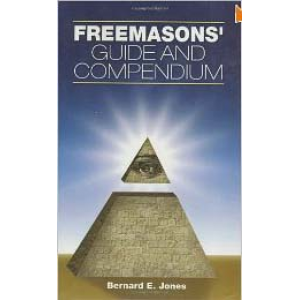
Book: Freemason Guide And Compendium by Bernard Jones
First published in 1950, the Freemasons' Guide and Compendium is filled with authentic, detailed information on a wide variety of subjects related to masons and masonry. Written by an experienced Freemason with the interests of rank-and-file members of the ordinary lodge in mind—especially the young Craftsman who wishes to learn the nature of Freemasonry's claim to have a history that goes back to ancient days—it provides key facts about masonic history, tradition, and lore. In doing so, the book offers a far greater scope of information than any other comparable work. And Bernard E. Jones critically examines conflicting ideas about how some of the traditions came to be, coming to conclusions of his own.The book is divided into six main sections:
1-Operative Masonry and the London Company
2-Speculative Masonry
3-The Grand Lodges (1717 - 1813)
4-The Craft Degrees and Other Matters
5-The Lodge and Many Related Subjects
6-The Royal Arch, Mark Masonry, and Additional Degrees
There are also 31 illustrated plates, and numerous other illustrations throughout the text.
There is so much in the "Freemason' Guide and Compendium" that it is difficult to describe the breadth of its content, and yet for all its amazing content Worshipful Br. Jones continues to hele, conceal, and never reveal an. o. t. scs. ars. prts. o. r. pnts. of. th. hdn. msts. o. fmy.
The early chapters of Freemasons' Guide and Compendium describe how the masonic guilds arose in eleven-century England after the Norman conquest. From there Jones moves into the emergence of speculative Freemasonry in the late medieval period and exlpores its amazing growth as an esoteric system during the eighteenth century.
The major part of the book consists of a comprehensive, systematic presentation of information about masonry's customs, principles and tenets, words and phrases, lodge appointments and working tools, symbols and emblems. With the help of the guide and compendium, the Craftsman will have no difficulty in making daily progress in masonic knowledge, and the thorough, exhaustive index will help him to access a great story of knowledge.
As interest in the subject of Freemasonry continues to grow, as seen in the movie National Treasure and in Dan Brown's forthcoming book, the Freemasons' Guide and Compendium will be a valuable source of information for anyone who wants to research and understand the masons.
For any Master Mason the "Freemason' Guide and Compendium" is an essential addition to his personal library and to that of the Lodge. An absolutely outstanding book! Highly Recommended!
Bernard E. Jones (1879 - 1965), a Freemason of fifty years, living in Sussex, England, was widely recognized as a great authority on the history, beliefs and symbols of Freemasonry. In the "Freemason' Guide and Compendium" Worshipful Br. Jones has given us a most excellent and detailed reference to the Craft.
Free eBooks (Can Be Downloaded):
Alan Wallace - Lucid Dreaming And MeditationShri Gurudev Mahendranath - Notes On Pagan India
Miac - Asatru And Odinism
Aleister Crowley - Freemason Letter On Crowley Status








